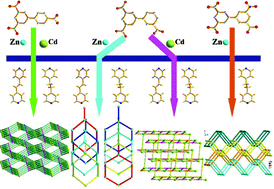Seven novel compounds, {[Zn2(L1)2]·2H2N(CH3)2·DMF}n (1), {[Cd2(L1)2]·2H2N(CH3)2·DMF}n (2), [Zn(HL2)(bpe)]n (3), [Zn2(HL2)2(bpea)2(H2O)]n (4), {[Cd2(HL2)2(bpe)(H2O)2]·2H2O}n (5), {[Cd2(HL2)2(bpea)(H2O)2]·2H2O}n (6) and {[Zn(HL3)(bpea)]·2H2O}n (7), were constructed based on three unsymmetrical tricarboxylate ligands and nitrogen-containing ligands (H3L1 = biphenyl-3,4′,5-tricarboxylic acid, H3L2 = biphenyl-3,3′,5-tricarboxylic acid, H3L3 = biphenyl-3-nitro-5,3′,5′-tricarboxylic acid, bpe = 1,2-bi(4-pyridyl)ethylene, bpea = 1,2-bi(4-pyridyl)ethane) under hydrothermal conditions. The positional isomeric and substituent effects of these ligands lead to fascinating structures. Compounds 1 and 2 afford 3D (3,6)-connected (4.62)2(42.610.83) rutile topologies based on dinuclear M2(CO2)2 SBUs. Compounds 3 and 4 are 4-connected diamondoid nets, which exhibit unusual roto-translational [2 + 2]-fold and common 4-fold interpenetration due to the different weak interactions among each interpenetrating motif, respectively. Compounds 5 and 6 are isostructural, both presenting 2D unique undulated (3,4)-connected (42.6)(42.63.8) topologies. Compound 7 possesses a 2D → 3D parallel polycatenation framework composed of (4,4) undulated sheets. The effects of the positions of the carboxylate groups and the substituent groups on the aromatic rings, the flexibility of the N-containing coligands as well as the coordination geometry of the metal centers are discussed in details. The fluorescence properties and thermal stability of the ligands and compounds have also been performed.


 Please wait while we load your content...
Please wait while we load your content...